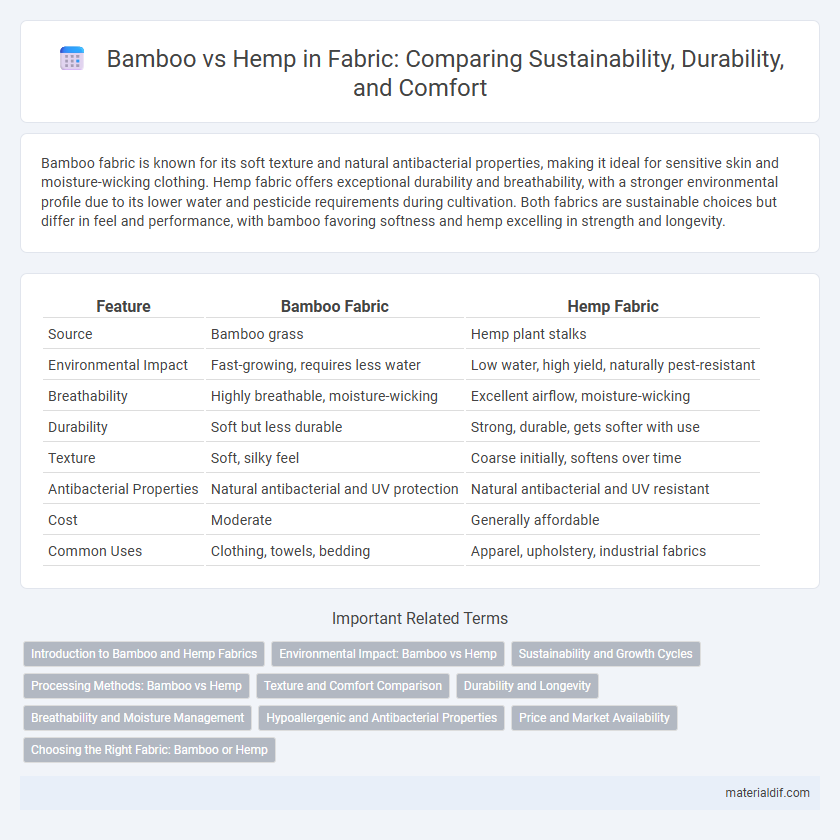Bamboo fabric is known for its soft texture and natural antibacterial properties, making it ideal for sensitive skin and moisture-wicking clothing. Hemp fabric offers exceptional durability and breathability, with a stronger environmental profile due to its lower water and pesticide requirements during cultivation. Both fabrics are sustainable choices but differ in feel and performance, with bamboo favoring softness and hemp excelling in strength and longevity.
Table of Comparison
| Feature | Bamboo Fabric | Hemp Fabric |
|---|---|---|
| Source | Bamboo grass | Hemp plant stalks |
| Environmental Impact | Fast-growing, requires less water | Low water, high yield, naturally pest-resistant |
| Breathability | Highly breathable, moisture-wicking | Excellent airflow, moisture-wicking |
| Durability | Soft but less durable | Strong, durable, gets softer with use |
| Texture | Soft, silky feel | Coarse initially, softens over time |
| Antibacterial Properties | Natural antibacterial and UV protection | Natural antibacterial and UV resistant |
| Cost | Moderate | Generally affordable |
| Common Uses | Clothing, towels, bedding | Apparel, upholstery, industrial fabrics |
Introduction to Bamboo and Hemp Fabrics
Bamboo fabric is derived from the pulp of bamboo grass, offering natural antibacterial and moisture-wicking properties that enhance comfort and durability. Hemp fabric, made from the fibers of the hemp plant, is renowned for its strength, breathability, and eco-friendly cultivation requiring minimal water and pesticides. Both fabrics are sustainable alternatives to conventional textiles, contributing to environmentally responsible fashion and interior design.
Environmental Impact: Bamboo vs Hemp
Hemp cultivation requires significantly less water and fewer pesticides compared to bamboo, making it a more sustainable choice for fabric production. Bamboo grows rapidly but often involves chemical-intensive processing methods that can harm the environment. Hemp's minimal soil depletion and fast growth cycle contribute to its superior environmental footprint in textile manufacturing.
Sustainability and Growth Cycles
Bamboo fabric is highly sustainable due to its rapid growth cycle, often reaching maturity within 3 to 5 years, requiring minimal water and no pesticides. Hemp fabric offers exceptional environmental benefits with a growth cycle of about 4 months, demanding little water, and enriching soil health through nitrogen fixation. Both fibers significantly reduce reliance on synthetic materials, but hemp's shorter cultivation period and regenerative properties make it a superior choice for eco-friendly textile production.
Processing Methods: Bamboo vs Hemp
Bamboo fabric is produced through either mechanical crushing and retting of bamboo fibers or chemical processing using solvents to extract viscose or rayon, which can involve harsh chemicals affecting the environment. Hemp undergoes mechanical processing by retting and scutching to separate fibers, which requires fewer chemicals and results in a stronger, more durable textile. The processing of hemp is generally more sustainable and less chemically intensive compared to the often chemically-heavy methods used for bamboo fabric production.
Texture and Comfort Comparison
Bamboo fabric offers a silky, smooth texture that feels exceptionally soft against the skin, making it ideal for sensitive skin types. Hemp fabric, while coarser initially, softens significantly with use and washing, providing durable comfort and breathability. Both fabrics boast moisture-wicking properties, yet bamboo excels in maintaining a cooler feel, whereas hemp delivers a sturdier, more structured wear.
Durability and Longevity
Bamboo fabric exhibits excellent durability due to its natural antibacterial properties and high tensile strength, making it resistant to wear and tear over time. Hemp fabric surpasses most natural fibers in longevity, known for its exceptional toughness and ability to maintain structural integrity through repeated use and washing. Both fabrics offer sustainable options, but hemp's superior abrasion resistance and long-lasting fibers make it the optimal choice for products requiring extended durability.
Breathability and Moisture Management
Bamboo fabric offers superior breathability due to its micro-gaps and micro-holes structure, which promotes excellent air circulation and keeps the skin cool. Hemp fabric excels in moisture management with its natural ability to wick sweat away from the body, drying quickly and reducing bacterial growth. Both fibers provide eco-friendly alternatives, but bamboo is preferred for enhanced ventilation, while hemp is favored for its efficient moisture absorption and durability.
Hypoallergenic and Antibacterial Properties
Bamboo fabric is renowned for its natural antibacterial properties, which inhibit the growth of bacteria and reduce odors, making it an excellent choice for sensitive skin and allergy sufferers. Hemp fabric also possesses hypoallergenic qualities, as it is resistant to mold and mildew, ensuring less irritation for those with skin sensitivities. Both fabrics offer breathable, moisture-wicking benefits that promote comfort while minimizing allergic reactions.
Price and Market Availability
Bamboo fabric tends to be more affordable and widely available in mainstream markets due to its fast-growing nature and lower production costs. Hemp fabric, while more durable and eco-friendly, often comes at a higher price point because of its limited cultivation and more intensive processing methods. Market availability for hemp remains niche and growing primarily within sustainable fashion sectors, whereas bamboo is readily accessible across various textile retailers.
Choosing the Right Fabric: Bamboo or Hemp
Bamboo fabric offers exceptional softness, moisture-wicking properties, and natural antibacterial benefits, making it ideal for comfortable, breathable clothing. Hemp fabric boasts remarkable durability, UV resistance, and eco-friendly attributes due to its low water usage and quick growth cycle, perfect for sustainable fashion and heavy-duty textiles. Selecting between bamboo and hemp depends on prioritizing either softness and breathability or strength and environmental impact for your fabric needs.
bamboo vs hemp Infographic

 materialdif.com
materialdif.com